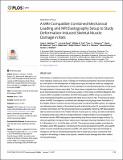A MRI-Compatible Combined Mechanical Loading and MR Elastography Setup to Study Deformation-Induced Skeletal Muscle Damage in Rats
Author(s)
Nelissen, Jules L.; de Graaf, Larry; Traa, Willeke A.; Schreurs, Tom J. L.; Nederveen, Aart J.; Sinkus, Ralph; Oomens, Cees W. J.; Nicolay, Klaas; Strijkers, Gustav J.; Moerman, Kevin M; ... Show more Show less
DownloadNelissen-2017-A MRI-Compatible Combined Mechan.pdf (4.442Mb)
PUBLISHER_CC
Publisher with Creative Commons License
Creative Commons Attribution
Terms of use
Metadata
Show full item recordAbstract
Deformation of skeletal muscle in the proximity of bony structures may lead to deep tissue injury category of pressure ulcers. Changes in mechanical properties have been proposed as a risk factor in the development of deep tissue injury and may be useful as a diagnostic tool for early detection. MRE allows for the estimation of mechanical properties of soft tissue through analysis of shear wave data. The shear waves originate from vibrations induced by an external actuator placed on the tissue surface. In this study a combined Magnetic Resonance (MR) compatible indentation and MR Elastography (MRE) setup is presented to study mechanical properties associated with deep tissue injury in rats. The proposed setup allows for MRE investigations combined with damage-inducing large strain indentation of the Tibialis Anterior muscle in the rat hind leg inside a small animal MR scanner. An alginate cast allowed proper fixation of the animal leg with anatomical perfect fit, provided boundary condition information for FEA and provided good susceptibility matching. MR Elastography data could be recorded for the Tibialis Anterior muscle prior to, during, and after indentation. A decaying shear wave with an average amplitude of approximately 2 μm propagated in the whole muscle. MRE elastograms representing local tissue shear storage modulus Gd showed significant increased mean values due to damage-inducing indentation (from 4.2 ± 0.1 kPa before to 5.1 ± 0.6 kPa after, p<0.05). The proposed setup enables controlled deformation under MRI-guidance, monitoring of the wound development by MRI, and quantification of tissue mechanical properties by MRE. We expect that improved knowledge of changes in soft tissue mechanical properties due to deep tissue injury, will provide new insights in the etiology of deep tissue injuries, skeletal muscle damage and other related muscle pathologies.
Date issued
2017-01Department
Massachusetts Institute of Technology. Media LaboratoryJournal
PLoS ONE
Publisher
Public Library of Science
Citation
Nelissen, Jules L.; de Graaf, Larry; Traa, Willeke A.; Schreurs, Tom J. L.; Moerman, Kevin M.; Nederveen, Aart J.; Sinkus, Ralph; Oomens, Cees W. J.; Nicolay, Klaas and Strijkers, Gustav J. “A MRI-Compatible Combined Mechanical Loading and MR Elastography Setup to Study Deformation-Induced Skeletal Muscle Damage in Rats.” Edited by Christophe Egles. PLOS ONE 12, no. 1 (January 2017): e0169864 © 2017 Nelissen et al
Version: Final published version
ISSN
1932-6203